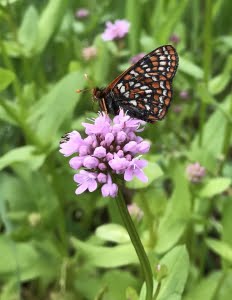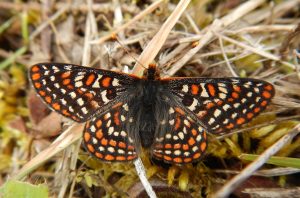
Better Late than Never: Patience with a Delayed Butterfly Season
This year, Willamette Valley biologists waited, waited and still waited longer for our favorite prairie pollinators, Taylor’s checkerspot butterfly and Fender’s blue butterfly, to emerge. Not one, not two, but almost three weeks late! Cold and rainy conditions delayed both plants and butterflies this year. These two endangered butterflies are the driver for much of the prairie habitat restoration IAE tackles on a year to year basis in collaboration with partners like the US Fish and Wildlife Service. They are quite near and dear to our hearts, hence the anxiety over their late appearance.


Beyond its handful of locations in Washington and British Columbia, Taylor’s checkerspot only occurs in two locations in Oregon, both in our own Benton County. IAE works closely with Benton County Natural Areas and Parks, and a local landowner, to enhance habitat at both sites. A big part of habitat restoration for this butterfly is seeding native nectar flowers, like rosy plectritis, for the butterfly, and working to control nasty invasive plants, like false brome and hawthorn.


Fender’s blue butterfly is also an endangered species, relying on Willamette Valley prairies with Kincaid’s lupine (or occasionally, spurred or sickle keel lupine). This is the second year IAE has coordinated ten surveyors (including two IAE staff) to monitor Fender’s blue butterfly populations across the valley, on public and private lands, from West Eugene and Coburg Hills all the way up to Hagg Lake. Like Taylor’s checkerspot, Fender’s blue’s worst enemies are invasive plants, especially tall oatgrass, blackberry, and Scotch broom! Habitat restoration and regular maintenance are essential for populations of the butterfly to persist.
The season is winding to a close, and data are coming in - fingers are crossed that both Taylor’s and Fender’s weathered this year’s stormy spring and laid plenty of eggs for next year’s butterfly season!
A huge thanks to all our butterfly surveyors: Dana Ross, Greg Fitzpatrick, Duncan Thomas, Paul Hammond, Paul Severns, Lee Bennion, Gary Pearson, Jock Beall, and IAE’s own Carolyn Menke and Lindsay Willrick!
Restoration
Research
Education
Contact
Main Office:
4950 SW Hout Street
Corvallis, OR 97333-9598
541-753-3099
info@appliedeco.org
Southwest Office:
1202 Parkway Dr. Suite B
Santa Fe, NM 87507
(505) 490-4910
swprogram@appliedeco.org
© 2025 Institute for Applied Ecology | Privacy Policy
